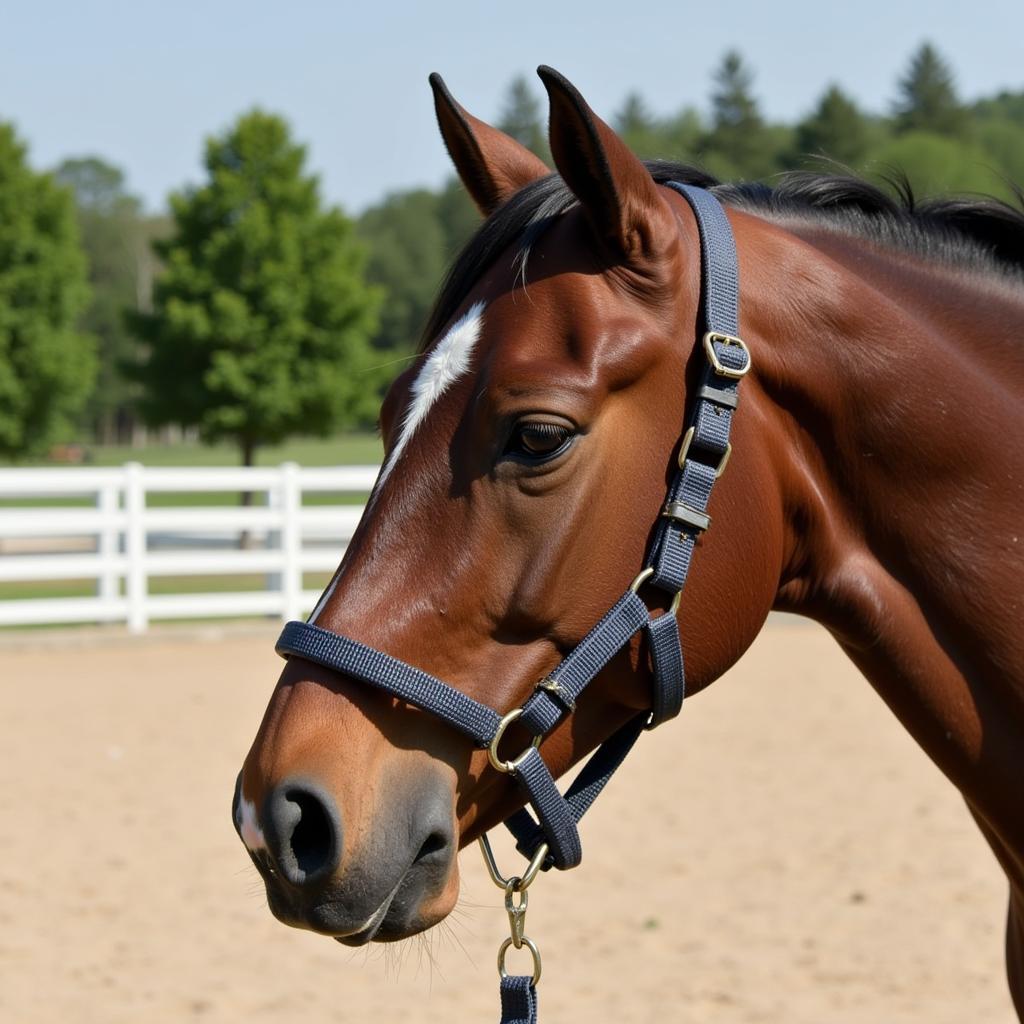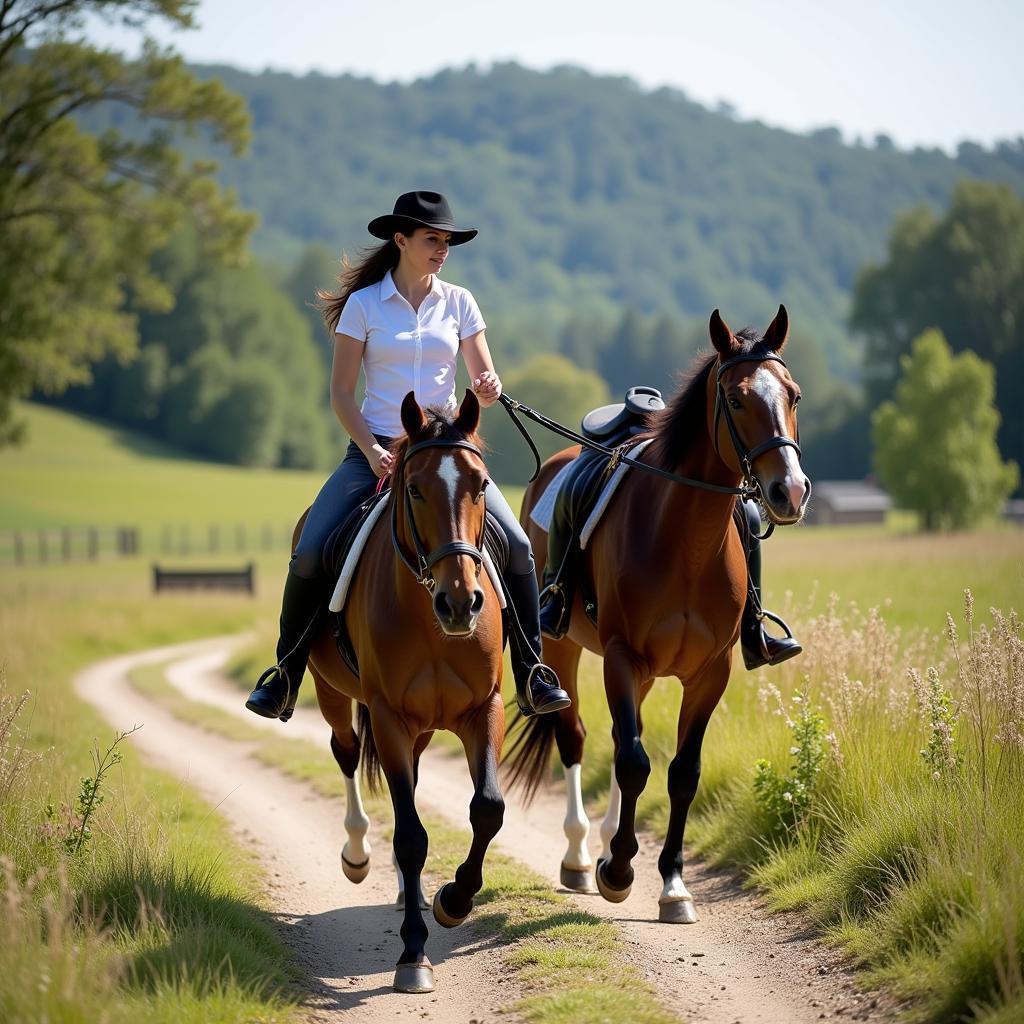“How To Pony A Horse” is a question many equestrians ask, especially those new to handling multiple horses. While seemingly straightforward, it requires skill, patience, and a deep understanding of horse behavior to ensure safety and success. This guide delves into the intricacies of ponying, equipping you with the knowledge to master this valuable equestrian technique.
Understanding the Art of Ponying
Ponying refers to the practice of leading one horse while mounted on another. It’s a common practice for various reasons, from exercising two horses simultaneously to acclimating young or green horses to trail experiences. However, it’s not simply about tethering two horses together; it demands clear communication, trust, and awareness of both animals’ responses.
Preparation is Key
Before you even think about mounting, ensure you have the right equipment and a safe environment:
- Proper Tack: Your riding horse requires a secure saddle and bridle. For the horse being ponied, use a well-fitted halter and a sturdy lead rope – ideally, one with a chain shank for added control if needed.
- Safe Space: Choose a controlled area free from obstacles and distractions. A round pen or an enclosed arena are excellent starting points. Avoid busy roads or unpredictable terrains, especially with inexperienced horses.
 Essential Ponying Equipment
Essential Ponying Equipment
Introducing the Horses
The initial introduction can set the tone for the entire experience:
- Gradual Familiarization: Allow both horses to see and smell each other before any physical contact. This can prevent sudden reactions stemming from fear or surprise.
- Positive Reinforcement: Offer treats and verbal praise when both horses exhibit calm and accepting behavior. This positive association helps build their confidence and trust in the situation.
Mastering the Technique
- Positioning is Crucial: Position yourself on the riding horse so the horse being ponied is on your dominant side. This allows for better control and visibility.
- Maintaining a Safe Distance: Keep a safe distance between both horses, ideally the length of the lead rope. This prevents the ponied horse from crowding your riding horse or getting tangled in the lead.
- Clear Communication: Use clear and consistent aids for both horses. Your riding horse should respond to your leg and rein cues, while the horse being ponied should follow your body language and lead rope signals.
 Correct Positioning for Ponying
Correct Positioning for Ponying
Common Challenges and Solutions
- Pulling Back: If the horse being ponied resists, avoid pulling directly. Instead, use a series of short, firm tugs on the lead rope to encourage forward movement.
- Crowding: If the ponied horse gets too close, use your leg to guide your riding horse slightly away, creating space and re-establishing a safe distance.
- Excitement: If either horse gets excited, remain calm and assertive. Use your aids to maintain control and redirect their attention until they settle.
“When introducing ponying, start slow and prioritize safety,” advises Sarah Williams, a seasoned horse trainer from Kentucky. “Begin with short sessions in controlled environments, gradually increasing the duration and complexity as both horses become comfortable.”
Building Confidence and Trust
Remember, ponying is not just a physical exercise; it’s an opportunity to strengthen the bond between you and your horses. Patience, consistency, and positive reinforcement are essential for success. As you practice and refine your technique, you’ll develop a deeper understanding of your horses’ individual personalities and build a foundation of trust for future adventures.
Conclusion
Mastering the art of ponying a horse takes time, patience, and dedication. By following the steps outlined in this guide and prioritizing safety at all times, you can enjoy the many benefits this technique offers. Remember, a calm and confident approach will go a long way in building a successful ponying experience for both you and your equine partners.
For more information on horse care and training, check out our horse terms to know.
 Successful Ponying in Action
Successful Ponying in Action
Frequently Asked Questions
Can any horse be ponied?
Not all horses are suitable for ponying. Some might be too dominant, reactive, or inexperienced. It’s crucial to assess each horse’s temperament and training level beforehand.
What if my horse has never been ponied before?
Start by introducing the concept gradually. Have an experienced horse and handler assist you in a controlled environment, allowing the new horse to observe and adjust.
Can I pony a horse while riding a different type of equine?
While possible, it’s generally recommended to pony using a similar type of equine, such as a horse with another horse. This minimizes potential size and gait discrepancies, making the experience smoother for all involved.
What are some signs of stress in a horse being ponied?
Look for pinned ears, tail swishing, tense muscles, or resistance to moving forward. If you notice these signs, stop, reassess the situation, and address any potential issues before continuing.
If you need any assistance or have questions about ponying your horse, our team at Justus Horses USA is here to help. Contact us at Phone Number: 0772127271, Email: [email protected] or visit our address: QGM2+WX2, Vị Trung, Vị Thuỷ, Hậu Giang, Việt Nam. We have a 24/7 customer support team.